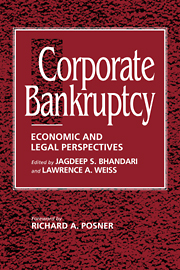Book contents
- Frontmatter
- Contents
- List of tables and figures
- Foreword by the HONORABLE RICHARD A. POSNER
- Preface
- Part I The role of credit
- Part II Bankruptcy as a reflection of the creditors' implicit bargain
- Part III Beyond the basic creditors' bargain
- Part IV Workouts or bargaining in the shadow of bankruptcy
- Part V Alternatives to bankruptcy and the creditors' bargain
- 21 Corporate control and the politics of finance
- 22 The uneasy case for corporate reorganizations
- 23 Bankruptcy and debt: A new model for corporate reorganization
- 24 A new approach to corporate reorganizations
- 25 Debtor's choice: A menu approach to corporate bankruptcy
- 26 Is corporate bankruptcy efficient?
- 27 The voting prohibition in bond workouts
- 28 Financial and political theories of American corporate bankruptcy
- Part VI Experience of other countries
- Index
24 - A new approach to corporate reorganizations
Published online by Cambridge University Press: 10 December 2009
- Frontmatter
- Contents
- List of tables and figures
- Foreword by the HONORABLE RICHARD A. POSNER
- Preface
- Part I The role of credit
- Part II Bankruptcy as a reflection of the creditors' implicit bargain
- Part III Beyond the basic creditors' bargain
- Part IV Workouts or bargaining in the shadow of bankruptcy
- Part V Alternatives to bankruptcy and the creditors' bargain
- 21 Corporate control and the politics of finance
- 22 The uneasy case for corporate reorganizations
- 23 Bankruptcy and debt: A new model for corporate reorganization
- 24 A new approach to corporate reorganizations
- 25 Debtor's choice: A menu approach to corporate bankruptcy
- 26 Is corporate bankruptcy efficient?
- 27 The voting prohibition in bond workouts
- 28 Financial and political theories of American corporate bankruptcy
- Part VI Experience of other countries
- Index
Summary
Introduction
The concern of this chapter is the way in which corporate reorganizations divide the reorganization pie. The chapter puts forward a new method for making the necessary division. This method can address some major efficiency and fairness problems long thought to be inherent in corporate reorganizations. Although the method is proposed as a basis for law reform, it can also be used under the existing rules.
Reorganization is one of the two routes that a corporation bankruptcy may take. When a corporation becomes insolvent and bankruptcy proceedings are commenced, the corporation is either liquidated or reorganized. In liquidation, which is governed by chapter 7 of the Bankruptcy Code, the assets of the corporation are sold, either piecemeal or as a going concern. The proceeds from this sale are then divided among those who have rights against the corporation, with the division made according to the ranking of these rights.
Reorganization which is governed by chapter 11 of the Bankruptcy Code, is an alternative to liquidation. Reorganization is essentially a sale of a company to the existing “participants” – all those who hold claims against or interests in the company. This “sale” is of course a hypothetical one. The participants pay for the company with their existing claims and interests; in exchange, they receive K “tickets” in the reorganized company – that is, claims against or interests in this new entity.
- Type
- Chapter
- Information
- Corporate BankruptcyEconomic and Legal Perspectives, pp. 370 - 394Publisher: Cambridge University PressPrint publication year: 1996
- 1
- Cited by



